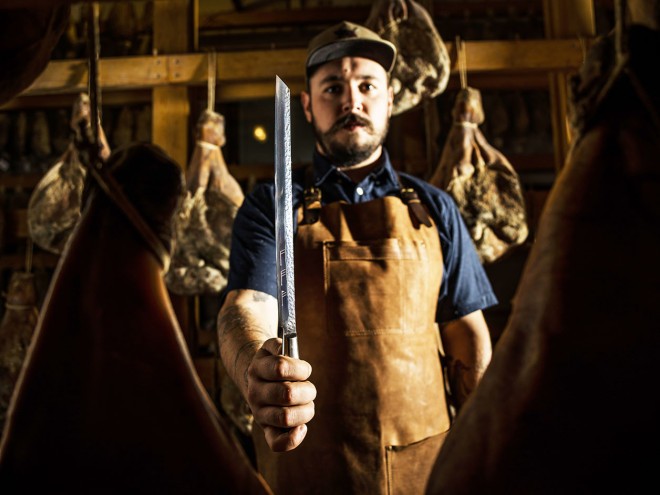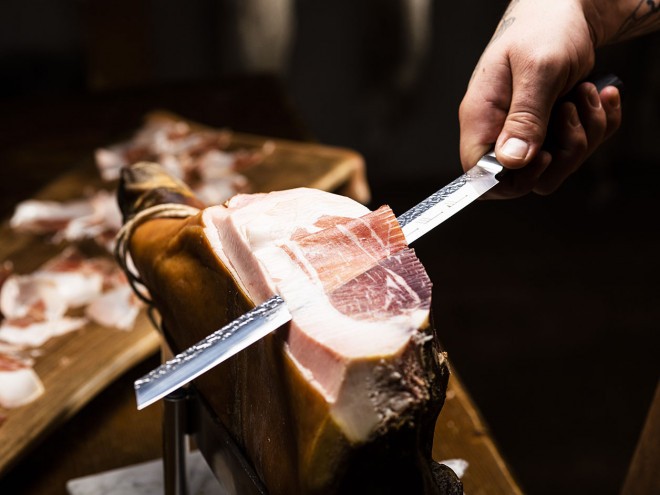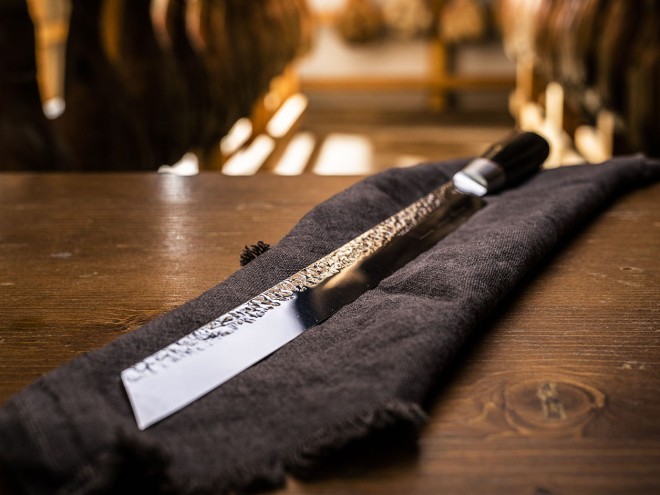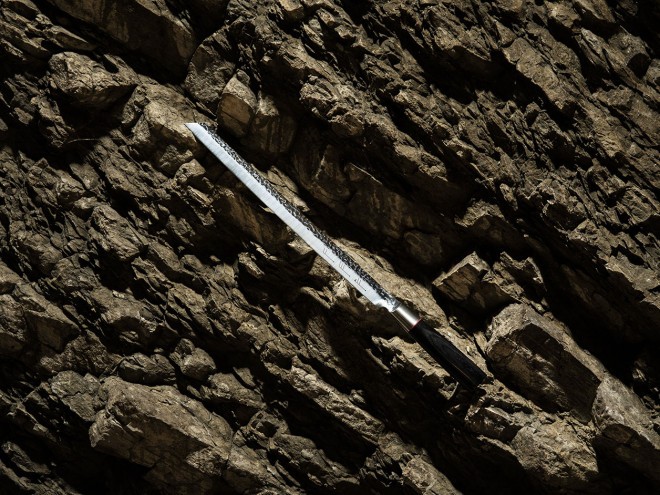The kitchen knife was first used by Homo habilis a million years before fire was known as a tool for preparing and sharing food with others. With its primary utility, such a knife still defines the essence of modern man, but it has changed a lot from its stone beginnings to today. It is the prosciutto knife that embodies this ancient essence of a rudimentary knife, when a dried piece of meat is cut and shared with friends.
Many years of experience with Japanese knives, which Oster Rob brings to the space of European cuisine, is Luka Grmovšek years ago, in cooperation with Binet Volčič, poured into a customized Japanese knife Bunka ZDP-189, but this time with The storm represents a unique innovation for all prosciutto cutters, both home enthusiasts and professionals.

Why a prosciutto knife?
Very simply because there is none. The idea was born in many conversations over wine and prosciutto in different parts of the world, especially with experienced prosciutto cutters, because the topic of what would be the best knife was brought up again and again.
No one has yet devoted enough attention and love to making a knife that would really meet all the needs of cutting prosciutto and be really good at it. It is particularly difficult to make a universal knife, as there are many prosciuttos and cutting techniques.
Why did you decide to manufacture in Japan?
We have a rich tradition of prosciutto, but we don't have a tradition of forging knives, so the answer was obvious to make a prosciutto knife in Japan, because Japanese blacksmiths with their blacksmithing tradition, knowledge and their steels are by far the best in the world. The problem arises because the Japanese do not have prosciutto and the tradition of cutting prosciutto, so they do not have any basis for making a prosciutto knife. So the prosciutto knife became our first project, which we started from scratch.
How did you combine these two worlds?
The story really began two years ago, when the idea of a prosciutto knife was burning in my mind and I was expecting a visit from a Japanese blacksmith. The first challenge was convincing traditional Japanese blacksmiths to join us on the path of experimentation. It should be noted that with the Japanese, especially with the old blacksmiths, change is something they allow in very small amounts, the whole thing can take many years and is very slow. They are not too open to innovation and experimentation. At the same time, this is their advantage as the key to their superior blacksmithing skills. The long-standing blacksmithing tradition is passed down from generation to generation with minimal changes and a very slow but constant positive development.
I knew it would be difficult to convince the old blacksmith to try something new. At the same time, I knew another thing about the Japanese and their customs that gave me hope. It's hard to convince them and get them excited about change, but once they get excited and decide, they always go all the way.
I had another trump card up my sleeve, because the blacksmith's wife is a sommelier and they both like to enjoy good wines, and in Slovenia we certainly have something to show in this area. After visiting quite a few selected wine cellars and cutting dry meats, one late evening, when Robi was cutting prosciutto for us in Čompa, and Renčel was pouring his wine, our Japanese guest grabbed a prosciutto knife and made a typical Japanese grunt - hmmmm, emmm - which is meant a green light.
This was followed by conversations with knife makers, testing, searching for the right steel, difficult and complex analysis of handles. After more than two years, with many sliced prosciuttos and drunk wine, visits to Japan and forged steel, the process has come to an end, and this fall, our Burja will cut through the karst cellars for the first time.

And if we go by type: steel?
When making the knife, we used Japanese Aichi steel 1K6M VM, which keeps the blade sharp for a long time and is easy to resharpen. When we decide between the steels from which we want to make a knife, we consider properties such as hardness, ability to maintain sharpness, ease of maintenance, steel grain and ease of sharpening. The biggest challenge was to make the blade just flexible, since the hardness of the steel is 58hrc.
The shape?
The shape of the Burja is unique, although at first glance it looks similar to other prosciutto knives. It has an extremely thin blade that measures only 1.8 millimeters, and the concave secondary ramp helps the knife slide smoothly in long cuts. For the same purpose, even on the otherwise flat part of the blade, tsuchima irregularities or the remains of hammer impressions during forging are preserved. In this way, air is retained in bumps, which helps with sliding. The length of the blade is a respectable 30 centimeters and ends with a thin point that betrays the origin and tradition of blacksmiths trained on katanas. The blade profile is also slightly different, as the blade is not perfectly flat. The slight tension of the blade reduces the point of contact, which greatly facilitates the cutting itself. Flexibility is necessary to some extent when cutting, but at Burja we decided to use a slightly harder fex, because this makes it more versatile and suitable for several different types of prosciutto, and at the same time, with such properties, it also excels when cutting other larger pieces of dry meat .

The handle?
The choice of handle remains open for further exploration by Burja. It will be sold as standard with a Japanese handle adapted for cutting prosciutto, but as an option it will also be available with original inspirations from designers, artists and carpenters.
Forging?
Burja is forged at the Suncraft forge in Seki (Gifu Prefecture), a city known for making knives.
KNIFE FOR PROSCIOT BURJA
The invisible presence of the wind, that the great architect of nature, which creates breathtaking canyons, mighty cliffs, magical dunes, is also a key ingredient in some of the most characteristic flavors that have accompanied us for thousands of years. It is not often that we are reminded of this modest but undisputed king of natural beauty when looking at beautiful landscapes created by the wind, or at delicious plates of wind-dried delicacies that melt in the mouth. It is one of the few trophies where the proud manufacturers do not forget to praise their wind in every detail prosciutto. It is the sharpness of the north wind that cuts through the pores of eternity to the dedicated pieces of meat and slowly, with feeling, squeezes the juices out of them and locks every drop of flavor into perfect juiciness. That's what we have A storm.
Is there anything left for us but to complete the circle of respect in the wind of ripened taste in the last act, when we actually convert it into the pleasure of food? That's what it's meant for Ostre robu's first own product – a prosciutto knife, which is entirely designed with our own knowledge, and is coined at the already proverbial of the best blacksmiths in Japan and with carefully selected the most suitable Japanese steel.

More information:
osterrob.si
Photo: Miha Bratina
Burja (Slo.), bura (Cr.), bora (It.), borea (Lat.), north wind (Eng.) is a cold, dry, gusty north wind, without which there is no prosciutto, no matter where it is produced in the world. The knife is therefore engraved with signs for a strong northerly wind, and in each country where prosciutto is produced, it will be named after the local northerly wind that dries the prosciutto.






